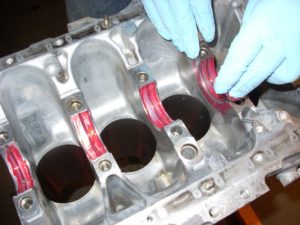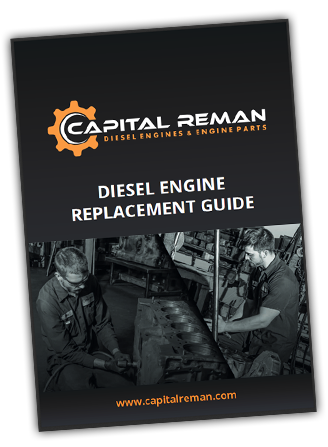What is the Best Type of Engine Assembly Grease?
 The life blood of any diesel engine is lubrication. A good diesel engine can go bad very quickly due to lack of oil. Long before oil enters the engine the assembly grease is the first line of defense against friction that can damage the engine upon startup. This article will explain the various methodologies to applying assembly grease and the best types of lubricants to use during the engine building process.
The life blood of any diesel engine is lubrication. A good diesel engine can go bad very quickly due to lack of oil. Long before oil enters the engine the assembly grease is the first line of defense against friction that can damage the engine upon startup. This article will explain the various methodologies to applying assembly grease and the best types of lubricants to use during the engine building process.
The diesel engine building process is one where patience and an eye for the detail is required. Engine building is both an art and a science where following specifications is critical. There is no grey area when it comes to manufacturing or rather remanufacturing a diesel engine. The internal hard parts are machined to correct OEM tolerances, then assembled with the right clearances and then properly lubricated with the right kind of engine assembly grease.
The first few minutes are the most crucial during the initial startup of an engine. A lot can go wrong with a freshly built engine. For example if the pre-lube is skipped the rings might not seat properly and the bearings could ride too tight or too loose. Many issues can snowball and cause catastrophic engine damage. Above all else, the oil delivery system has to build up the oil pressure within the engine so that all wear surfaces receive proper lubrication. Camshaft failure is a popular source of failure upon initially starting an engine without proper lubrication.
Assembly lube’s purpose is to provide the initial lubrication during the startup of the engine. The lube is designed to work in conjunction with standard engine oil and provide a more robust protective barrier around the metal components during startup.
After the initial startup of the engine much of the assembly lube is washed away within the first 10 seconds. The oil pressure should build up and flush away the lube which would then end up in the oil pan. Priming the oil system is important prior to cranking the engine as it prevents a completely dry start and cuts down the time it takes for oil to reach the camshaft, bearings and valve train. Essentially, priming the engine gives oil pressure a head start to build up. There are many different types of assembly lube and each diesel engine builder will favor one type or another. The most popular lubes are usually moly-based (Molybdenum Disulfide) and are designed to operate at high temperatures. Newer compounds are manufactured with additives that hold up better under extreme pressures and also act as rust inhibitors much like the compound Cosmoline.
There are many different types of assembly lube and each diesel engine builder will favor one type or another. The most popular lubes are usually moly-based (Molybdenum Disulfide) and are designed to operate at high temperatures. Newer compounds are manufactured with additives that hold up better under extreme pressures and also act as rust inhibitors much like the compound Cosmoline.
Each assembly lube is different in consistency and application. Most are like a thin and viscous, while others are a bit thicker. Some newer lubes are very light liquid mists that harden around metal surfaces. Many prefer traditional pastes because you can tell easily if all surfaces are covered. With liquid mists it can be easy to miss a spot or two.
Molybdenum Composite Greases
Molybdenum (Moly) based engine assembly lubrication has been around for 100+ years and became widely used in WWII. Molybdenum Disulfide comes from the mineral “Molybdenite” which was first used in metallurgy in 1330 Japan during the production of sword making. Molybdenum Disulfide was first synthesized into the compound as far back as the 1860s in Colorado and has been produced ever since. The first settlers and prospectors would use the substance to lubricate wagon wheel axles as well as machinery in foundries, smelters and refineries. It became commercially available in the 1920s and used extensively with automakers Ford and GM. These automakers used the product to lubricate millions of vehicle engines in World War II. After the war auto manufacturers continued to use the product on all of their engines. To this day the product works so well that the majority of automakers guarantee at least a 30,000 mile lubrication free period on the chassis and suspension. Ford guarantees 100,000 miles before re-lubrication is needed. Molybdenum Disulfide is a great lubricant because of its chemical composition. MoS2 is a hexagon crystal composed of a lattice structure of Sulphur and Molybdenum atoms. In layman terms the compound retains its laminar structure no matter the amount of heat or pressure. If the atomic bonds are pulverized the structure re-forms instantaneously so that no ionic bonds are ever truly broken. The compound is also very resistant to friction even at temperatures of 750 degrees F. Lastly, MoS2 has a great affinity to stick to metal surfaces very easily especially if rubbed in. Moly can withstand 500,000 pounds per square inch before completely breaking down. It does not dissolve in oil or grease and can be ground down to .35 micron. A micron can be consider 1 millionth of a meter of a particle suspended in a liquid. Moly reduces friction in an engine by 60% and is even manufactured into the engine components themselves. Many companies tout the effectiveness of Moly coated gearboxes, pistons, rings and bearings.
Molybdenum Disulfide is a great lubricant because of its chemical composition. MoS2 is a hexagon crystal composed of a lattice structure of Sulphur and Molybdenum atoms. In layman terms the compound retains its laminar structure no matter the amount of heat or pressure. If the atomic bonds are pulverized the structure re-forms instantaneously so that no ionic bonds are ever truly broken. The compound is also very resistant to friction even at temperatures of 750 degrees F. Lastly, MoS2 has a great affinity to stick to metal surfaces very easily especially if rubbed in. Moly can withstand 500,000 pounds per square inch before completely breaking down. It does not dissolve in oil or grease and can be ground down to .35 micron. A micron can be consider 1 millionth of a meter of a particle suspended in a liquid. Moly reduces friction in an engine by 60% and is even manufactured into the engine components themselves. Many companies tout the effectiveness of Moly coated gearboxes, pistons, rings and bearings.
In fact many synthetic oils use Moly (Molybdenum Trialkyldithiocarbamate (MoTDC)) or a related carbamate in the oil. It does not hurt the composition of the oil in anyway and in fact further lubricates the engines. Moly also has a way to find bind to minute cracks and imperfections in metal surfaces which can prevent metal fatigue. There is some debate though, whether MoTDC can damage the cam follower pins. Many engine builders refuse to use Moly lubricants on the camshaft or associated bearings. There may be some evidence that Molybdenum compounds in engine oils can degrade some bearings as it is aggressive towards copper. Most Molybdenum oils do indeed have a Copper Deactivator within the substance which will protect the bearings however the copper deactivator decomposes at relatively low temperatures and loses its potency only after 2,000-3,000 miles. Other reason many machinists do not use Molybdenum in engine rebuilds is due to the silicone balls within the lithium. These tiny silicone balls can clog the cam bearings and/or clog the oil filter. Despite the evidence or lack thereof, many engine builders opt not to use Moly on the camshaft. Some use a petroleum based lubricant on the cam lobes especially on flat tappets (solid or hydraulic).
Petroleum Based Greases
 The second most popular assembly lube, and the one we recommend the most, is Lubriplate #105. Lubricate #105 has been around almost as long as traditional Molybdenum Lubricates. Lubricate was founded in 1870 as Fiske Brothers Refining and is the oldest independent lubricator in the United States. Lubriplate #105 acts like a white lithium grease but contains no lithium. Lubricate #105 is not an Extreme Pressure (EP) lubricant like Moly based lubricants but rather a simple grease. It is a petroleum based heavy hydrotreated naphthenic distillate and also contains less than 1% of Zinc Dibutyldithiocarbamate (ZBDC) with a fatty acid of 5%-10% to act as a stabilizer. These additional compounds do not add to the lubricity of Lubriplate #105. The compound is white in color, waterproof and a NLGI No. 0 grease lubricant used for anti-seize properties used for coating all moving parts of the engine assembly. We like it as it is thinner and more easy to spread around hard to reach areas of the assembly.
The second most popular assembly lube, and the one we recommend the most, is Lubriplate #105. Lubricate #105 has been around almost as long as traditional Molybdenum Lubricates. Lubricate was founded in 1870 as Fiske Brothers Refining and is the oldest independent lubricator in the United States. Lubriplate #105 acts like a white lithium grease but contains no lithium. Lubricate #105 is not an Extreme Pressure (EP) lubricant like Moly based lubricants but rather a simple grease. It is a petroleum based heavy hydrotreated naphthenic distillate and also contains less than 1% of Zinc Dibutyldithiocarbamate (ZBDC) with a fatty acid of 5%-10% to act as a stabilizer. These additional compounds do not add to the lubricity of Lubriplate #105. The compound is white in color, waterproof and a NLGI No. 0 grease lubricant used for anti-seize properties used for coating all moving parts of the engine assembly. We like it as it is thinner and more easy to spread around hard to reach areas of the assembly.
Lubricate #105 is a dependable and cheap engine assembly grease to combat engine seizing upon startup. It is recommended that the crankshaft, crank case, pistons, rings, timing gears, main and rod bearings and valve stems absolutely be covered in Lubricate #105 but is safe to use on every moving part in an internal combustion or compression engine. Albeit there is some debate, it is recommended to use Lubricate #105 on the cam and lifters. Some engine builders will use a specific bearing grease on the cam an lifters. Bearing grease is very fine lubricant recommended for use on the engine bearings due to possibility of "spinning a bearing" upon startup. Some rebuilders will dip parts in transmission fluid before applying Lubriplate #105 as it seals in that added layer of lubrication and forms a tight seal. Each engine builder is different and has a unique approach to what type of assembly lube they prefer. The vast majority of engine builders seem to favor Lubricate #105 as it gets the job done without the risk of clogging the oil galleries in the cam bearings. There are many general engine assembly lubricates on the market from all kinds of automotive and diesel lubricant manufacturers as well as specialty products that only focus on the camshaft and bearings. Caterpillar makes their own proprietary greases for cam lobes, rocker balls and push rod cups. Each one is a little bit different and it can be overwhelming trying to decipher which lubricant is the best for your engine rebuild. It is important to do your homework and simply not buy something without knowing the chemical properties of the lubricant. Some lubricants are grease based and are not soluble in oil which means the solution will quickly be caught in the oil filter and drained into the oil pan. Others are oil soluble and will continue to circulate within then engine until the next oil change.
There are many general engine assembly lubricates on the market from all kinds of automotive and diesel lubricant manufacturers as well as specialty products that only focus on the camshaft and bearings. Caterpillar makes their own proprietary greases for cam lobes, rocker balls and push rod cups. Each one is a little bit different and it can be overwhelming trying to decipher which lubricant is the best for your engine rebuild. It is important to do your homework and simply not buy something without knowing the chemical properties of the lubricant. Some lubricants are grease based and are not soluble in oil which means the solution will quickly be caught in the oil filter and drained into the oil pan. Others are oil soluble and will continue to circulate within then engine until the next oil change.
In any case, regardless of what assembly grease you choose it works best with applied with a thin coating over all the internal hard parts of the engine. In areas where there is high friction such as the, lifter bottoms, cam lobes, pushrod ends, rocker arms and valve stem tips, crankcase and all bearings extra attention should be given to coat the surfaces with an extra amount of assembly grease.
The assembly grease should get the job done for those crucial 10 seconds or before the engine can establish oil pressure and lubricate the hard parts with oil. It is recommended that the new engine not sit idle for the first few hundred miles. It is best to put the engine under a moderate load at 1500-2000 RPMs and let the oil do its job. Once the new engine is broken in the assembly grease is no longer needed the motor oil can take over and do its job.




